Trends of Heat Waves and Cold Spells over 1951–2015 in Guangzhou, China
Abstract
:1. Introduction
2. Materials and Methods
2.1. Data Collection
2.2. Statistical Analysis
3. Results
4. Discussion
5. Conclusions
Acknowledgments
Author Contributions
Conflicts of Interest
References
- Stocker, T.F.; Qin, D.; Plattner, G.K.; Tignor, M.; Allen, S.K.; Boschung, J.; Nauels, A.; Xia, Y.; Bex, B.; Midgley, B.M. Climate Change 2013: The Physical Science Basis; Cambridge University Press: London, UK, 2013; pp. 161–162. [Google Scholar]
- Thamo, T.; Addai, D.; Pannell, D.J.; Robertson, M.J.; Thomas, D.T.; Young, J.M. Climate change impacts and farm-level adaptation: Economic analysis of a mixed cropping–livestock system. Agric. Syst. 2017, 150, 99–108. [Google Scholar] [CrossRef]
- Huang, C.; Barnett, A.G.; Wang, X.; Vaneckova, P.; Fitzgerald, G.; Tong, S. Projecting Future Heat-Related Mortality under Climate Change Scenarios: A Systematic Review. Environ Health Perspect. 2011, 119, 1681–1690. [Google Scholar] [CrossRef] [PubMed] [Green Version]
- Johnson, R.G.; Kandeh, M.; Jalloh, A.; Nelson, G.C.; Thomas, T.S. Sierra leone. In West African Agriculture and Climate Change: A Comprehensive Analysis; Jalloh, A., Nelson, G.C., Thomas, T.S., Zougmoré, R.B., Roy-Macauley, H., Eds.; International Food Policy Research Institute: Washington, DC, USA, 2015. [Google Scholar]
- White, B. Climate Change: Impacts, Adaptation, and Vulnerability; Cambridge University Press: London, UK, 2010. [Google Scholar]
- Meehl, G.A.; Tebaldi, C.; Walton, G.; Easterling, D.; Mcdaniel, L. Relative increase of record high maximum temperatures compared to record low minimum temperatures in the U.S. Geophys. Res. Lett. 2009, 36, 110–125. [Google Scholar] [CrossRef]
- Dash, S.K.; Mamgain, A. Changes in the Frequency of Different Categories of Temperature Extremes in India. J. Appl. Meteorol. Clim. 2011, 50, 1842–1858. [Google Scholar] [CrossRef]
- Sigmond, M.; Reader, M.C.; Fyfe, J.C.; Gillett, N.P. Drivers of past and future Southern Ocean change: Stratospheric ozone versus greenhouse gas impacts. Geophys. Res. Lett. 2011, 38. [Google Scholar] [CrossRef]
- Qian, W.; Wu, K.; Leung, J.C. Three-dimensional structure and long-term trend of heat wave events in western Eurasia revealed with an anomaly-based approach. Int. J. Climatol. 2016, 36, 4315–4326. [Google Scholar] [CrossRef]
- Cohen, J.; Screen, J.A.; Furtado, J.C.; Barlow, M.; Whittleston, D.; Coumou, D.; Francis, J.; Dethloff, K.; Entekhabi, D.; Overland, J. Recent Arctic amplification and extreme mid-latitude weather. Nat. Geosci. 2014, 7, 627–637. [Google Scholar] [CrossRef] [Green Version]
- Schubert, S.D.; Wang, H.; Koster, R.D.; Suarez, M.J.; Groisman, P.Y. Northern Eurasian heat waves and droughts. J. Clim. 2014, 27, 3169–3207. [Google Scholar] [CrossRef]
- Allen, S.M.J.; Gough, W.A.; Mohsin, T. Changes in the frequency of extreme temperature records for Toronto, Ontario, Canada. Theor. Appl. Climatol. 2015, 119, 481–491. [Google Scholar] [CrossRef]
- Perkins, S.E.; Alexander, L.V. On the Measurement of Heat Waves. J. Clim. 2013, 26, 4500–4517. [Google Scholar] [CrossRef]
- Rohini, P.; Rajeevan, M.; Srivastava, A.K. On the Variability and Increasing Trends of Heat Waves over India. Sci. Rep. UK 2016, 6, 26153. [Google Scholar] [CrossRef] [PubMed]
- Ye, D.-X.; Yin, J.-F.; Chen, Z.-H.; Zheng, Y.-F.; Wu, R.-J. Spatial and Temporal Variations of Heat Waves in China from 1961 to 2010. Adv. Clim. Chang. Res. 2014, 5, 66–73. [Google Scholar]
- Luo, D.; Xiao, Y.; Yao, Y.; Dai, A.; Simmonds, I.; Franzke, C.L.E. Impact of Ural Blocking on Winter Warm Arctic–Cold Eurasian Anomalies. Part I: Blocking-Induced Amplification. J. Clim. 2016, 29, 3925–3947. [Google Scholar] [CrossRef]
- Luo, D.; Xiao, Y.; Diao, Y.; Dai, A.; Franzke, C.L.E.; Simmonds, I. Impact of Ural Blocking on Winter Warm Arctic-Cold Eurasian Anomalies. Part II: The Link to the North Atlantic Oscillation. J. Clim. 2016, 29, 3949–3971. [Google Scholar] [CrossRef]
- Hou, Y.-L.; Chen, B.-D.; Yang, X.-C.; Liang, P. Observed Climate Change in East China during 1961 to 2007. Adv. Clim. Chang. Res. 2013, 4, 84–91. [Google Scholar]
- Zhang, Q.; Li, J.; Chen, Y.D.; Chen, X. Observed changes of temperature extremes during 1960 to 2005 in China: Natural or human-induced variations? Theor. Appl. Climatol. 2011, 106, 417–431. [Google Scholar] [CrossRef]
- Wang, W.; Zhou, W.; Chen, D. Summer high temperature extremes in Southeast China: Bonding with the El Niño–Southern oscillation and East Asian summer monsoon coupled system. J. Clim. 2014, 27, 4122–4138. [Google Scholar] [CrossRef]
- Wang, C.; Wang, X. Classifying El Niño Modoki I and II by different impacts on rainfall in Southern China and typhoon tracks. J. Clim. 2013, 26, 1322–1338. [Google Scholar] [CrossRef]
- Li, X.; Zhou, W. Quasi-4-yr coupling between El Niño-Southern Oscillation and water vapor transport over East Asia-WNP. J. Clim. 2012, 25, 5879–5891. [Google Scholar] [CrossRef]
- China Meteorological Data Network. Available online: http://data.cma.cn/data/index/6d1b5efbdcbf9a58.html (accessed on 20 December 2016).
- Climate Prediction Center of National Oceanic and Atmospheric Administration. Available online: http://www.cpc.noaa.gov/products/analysis_monitoring/ensostuff/ensoyears.shtml (accessed on 20 December 2016).
- Chinese National Climate Centre. Available online: http://cmdp.ncc-cma.net/Monitoring/cn_index_130.php (accessed on 20 December 2016).
- Chinese National Climate Centre. Available online: http://cmdp.ncc-cma.net/download/precipitation/diagnosis/IOBW/iobw-mon-history.tms (accessed on 20 December 2016).
- Chen, S.; Chen, W.; Wei, K. Recent trends in winter temperature extremes in eastern China and their relationship with the Arctic Oscillation and ENSO. Adv Atmos. Sci. 2013, 30, 1712–1724. [Google Scholar] [CrossRef]
- Peterson, T.C.; Zhang, X.; Brunet India, M.; Vázquez Aguirre, J.L. Changes in North American extremes derived from daily weather data. J. Geophys. Res. Atmos. 2008, 113. [Google Scholar] [CrossRef]
- Efthymiadis, D.; Goodess, C.M.; Jones, P.D. Trends in Mediterranean gridded temperature extremes and large-scale circulation influences. Nat. Hazard. Earth Syst. 2011, 11, 2199–2214. [Google Scholar] [CrossRef]
- Li, J.; Xu, X.; Ding, G.; Zhao, Y.; Zhao, R.; Xue, F.; Li, J.; Gao, J.; Yang, J.; Jiang, B.; et al. A Cross-Sectional Study of Heat Wave-Related Knowledge, Attitude, and Practice among the Public in the Licheng District of Jinan City, China. Int. J. Environ. Res. Public Health 2016, 13, 648. [Google Scholar] [CrossRef] [PubMed]
- Huang, W.; Kan, H.; Kovats, S. The impact of the 2003 heat wave on mortality in Shanghai, China. Sci. Total Environ. 2010, 408, 2418–2420. [Google Scholar] [CrossRef] [PubMed]
- Wu, M.C.; Leung, W.H. Effect of ENSO on the Hong Kong winter season. Atmos. Sci. Lett. 2009, 10, 94–101. [Google Scholar] [CrossRef]
- Bao, M.; Han, R. Delayed impacts of the El Niño episodes in the central Pacific on the summertime climate anomalies of eastern China in 2003 and 2007. Adv. Atmos. Sci. 2009, 26, 553–563. [Google Scholar] [CrossRef]
- Malhi, Y.; Wright, J. Spatial patterns and recent trends in the climate of tropical rainforest regions. Philos. Trans. R. Soc. B Biol. Sci. 2004, 359, 311–329. [Google Scholar] [CrossRef] [PubMed]
- Peng, W. The Third National Assessment Report on Climate Change. 2015. Available online: http://www.cma.gov.cn/en2014/news/News/201511/t20151123_298038.html (accessed on 20 December 2016). [Google Scholar]
- Simmonds, I. Comparing and contrasting the behaviour of Arctic and Antarctic sea ice over the 35 year period 1979–2013. Ann. Glaciol. 2015, 56, 18–28. [Google Scholar] [CrossRef]
- Screen, J.A.; Deser, C.; Simmonds, I.; Tomas, R. Atmospheric impacts of Arctic sea-ice loss, 1979–2009: Separating forced change from atmospheric internal variability. Clim. Dynam. 2014, 43, 333–344. [Google Scholar] [CrossRef] [Green Version]
- Boschat, G.; Pezza, A.; Simmonds, I.; Perkins, S.; Cowan, T.; Purich, A. Large scale and sub-regional connections in the lead up to summer heat wave and extreme rainfall events in eastern Australia. Clim. Dynam. 2015, 44, 1823–1840. [Google Scholar] [CrossRef]
- Ma, Z.F.; Liu, J.; Zhang, S.Q.; Chen, W.X.; Yang, S.Q. Observed Climate Changes in Southwest China during 1961–2010. Adv. Clim. Chang. Res. 2013, 4, 30–40. [Google Scholar] [CrossRef]
- Boschat, G.; Simmonds, I.; Purich, A.; Cowan, T.; Pezza, A.B. On the use of composite analyses to form physical hypotheses: An example from heat wave—SST associations. Sci. Rep. UK 2016, 6, 29599. [Google Scholar] [CrossRef] [PubMed]
- Donat, M.G.; Peterson, T.C.; Brunet, M.; King, A.D.; Almazroui, M.; Kolli, R.K.; Boucherf, D.; Al-Mulla, A.Y.; Nour, A.Y.; Aly, A.A. Changes in extreme temperature and precipitation in the Arab region: Long-term trends and variability related to ENSO and NAO. Int. J. Climatol. 2014, 34, 581–592. [Google Scholar] [CrossRef]
- Li, Y.; Wu, B.; Yang, Q.; Huang, S. Different relationships between spring SST in the Indian and Pacific oceans and summer precipitation in China. Acta Meteorol. Sin. 2013, 27, 509–520. [Google Scholar] [CrossRef]
- Kim, B.; Ha, K. Observed changes of global and western Pacific precipitation associated with global warming SST mode and mega-ENSO SST mode. Clim Dynam. 2015, 45, 3067–3075. [Google Scholar] [CrossRef]
- Brown, J.N.; Matear, R.J.; Brown, J.R.; Katzfey, J. Precipitation projections in the tropical Pacific are sensitive to different types of SST bias adjustment. Geophys. Res. Lett. 2015, 42, 10856–10866. [Google Scholar] [CrossRef]
- Zhou, C.; Wang, K. Coldest Temperature Extreme Monotonically Increased and Hottest Extreme Oscillated over Northern Hemisphere Land during Last 114 Years. Sci. Rep. UK 2016, 6, 25721. [Google Scholar] [CrossRef] [PubMed]
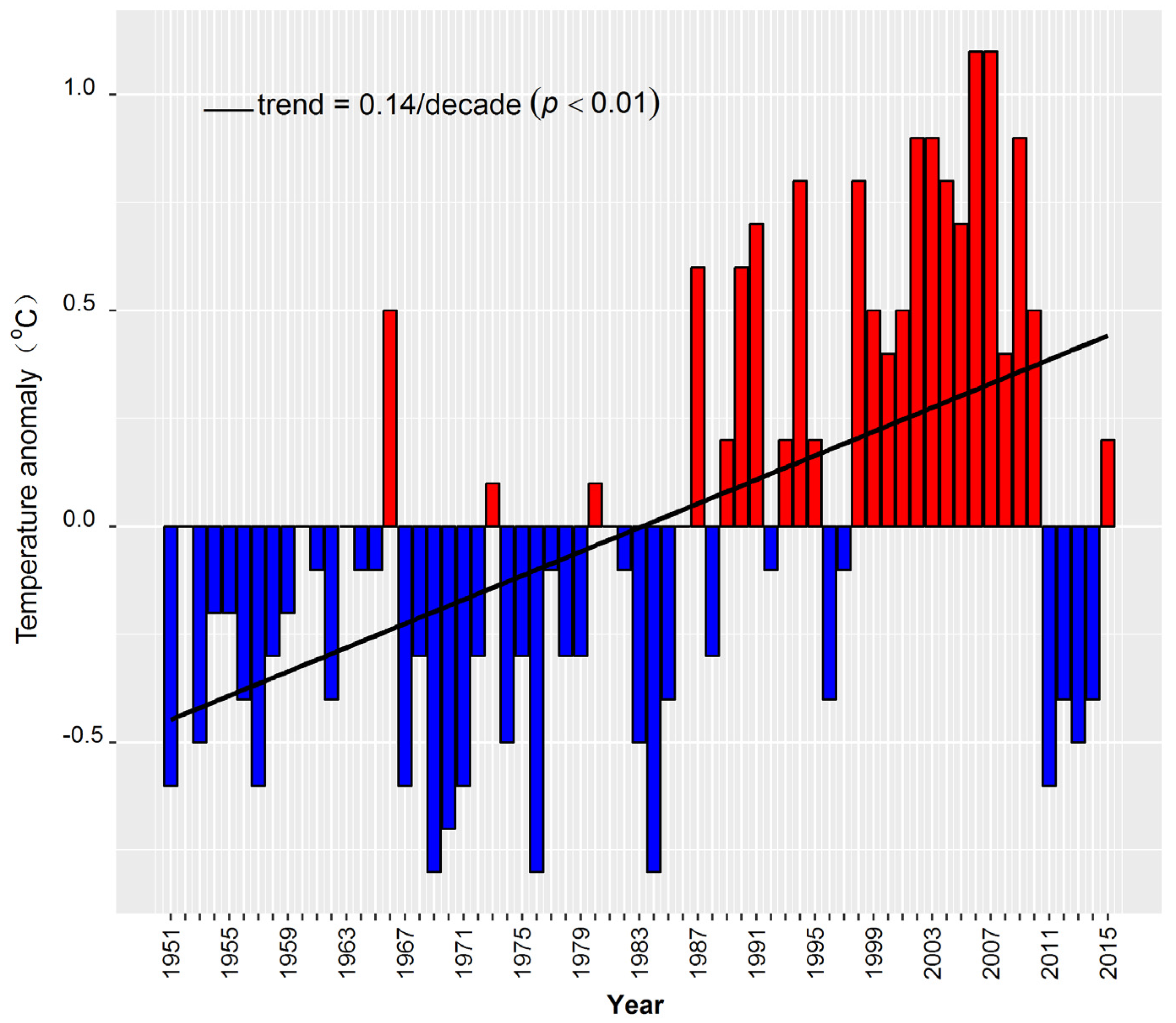
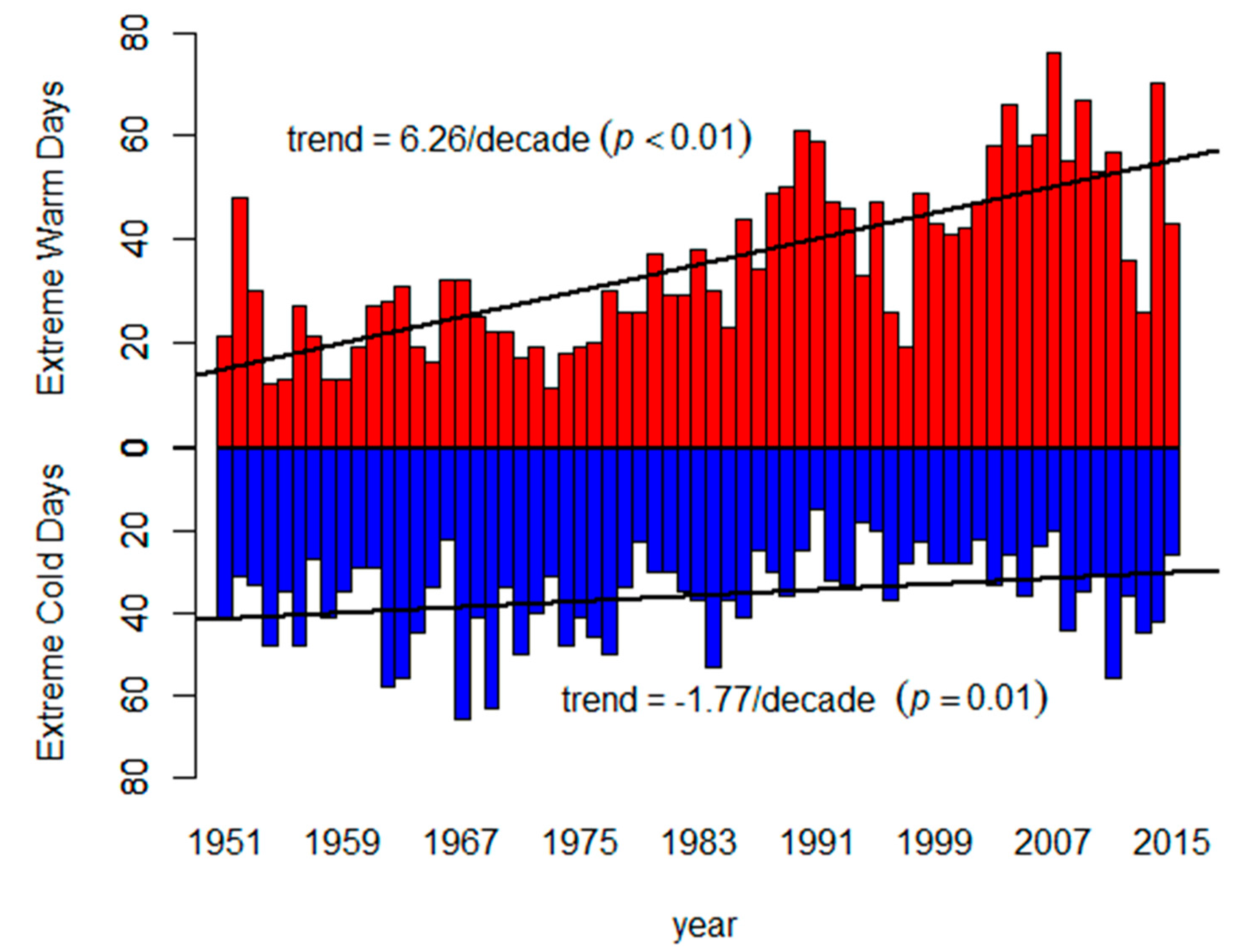
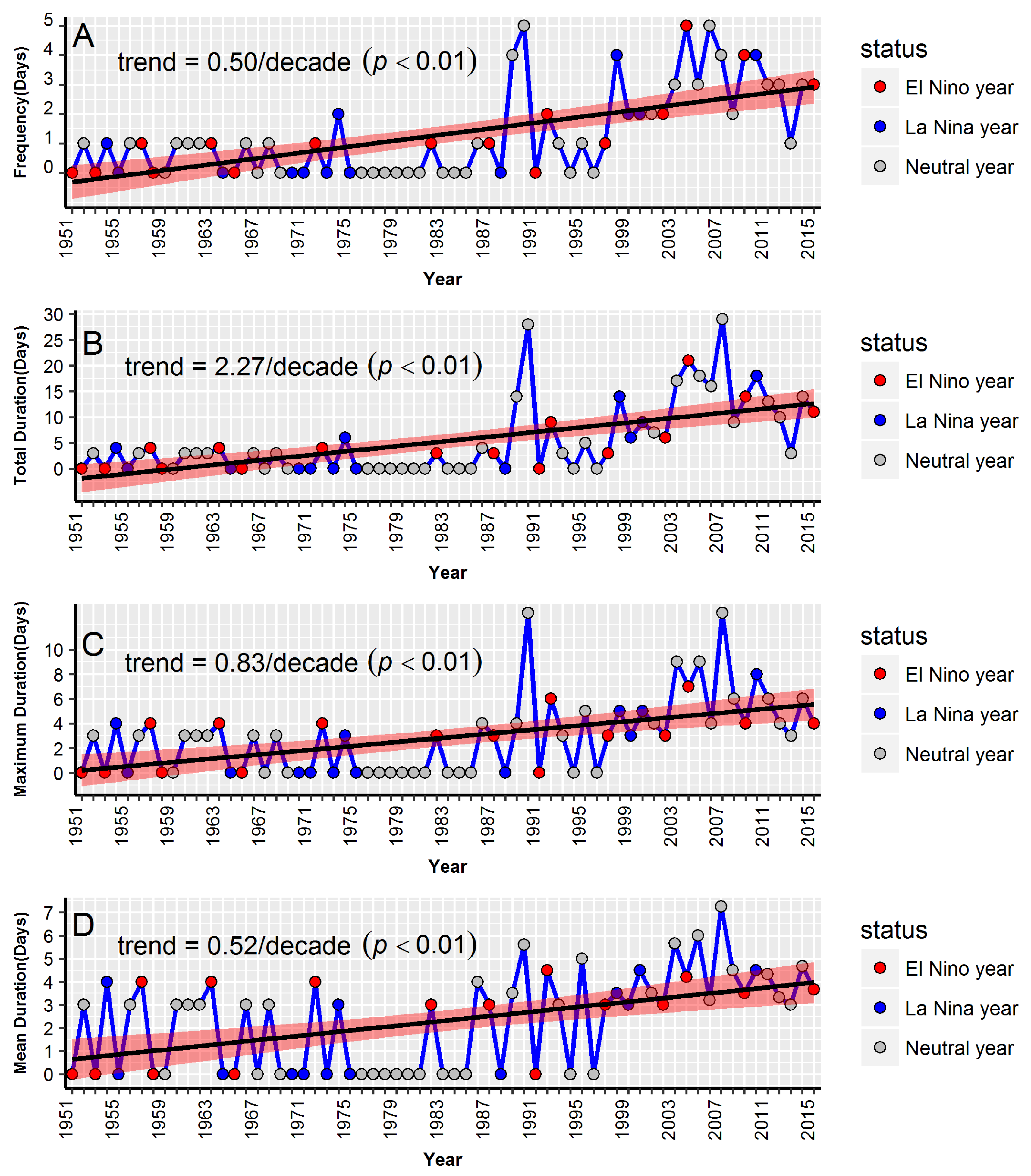
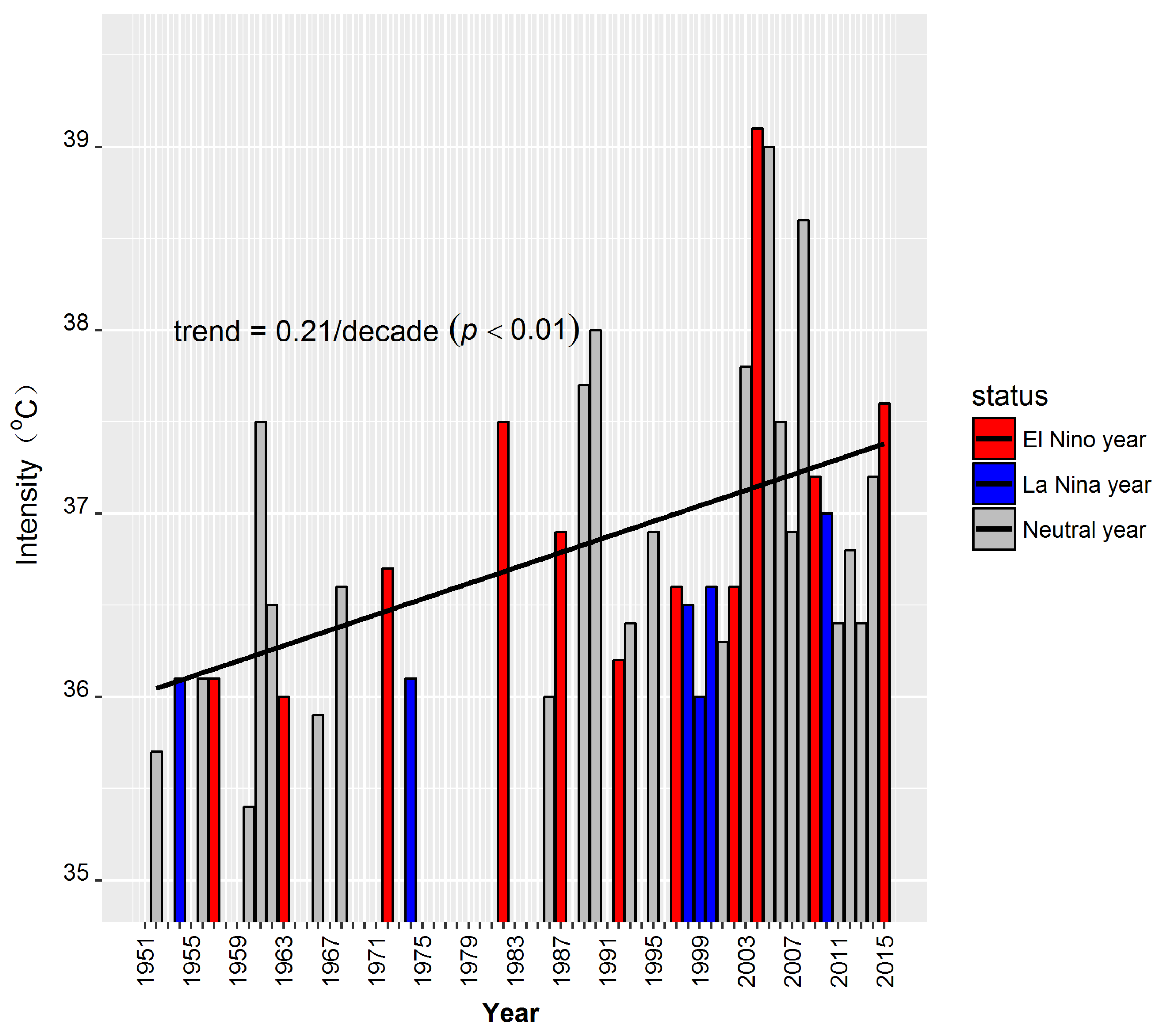
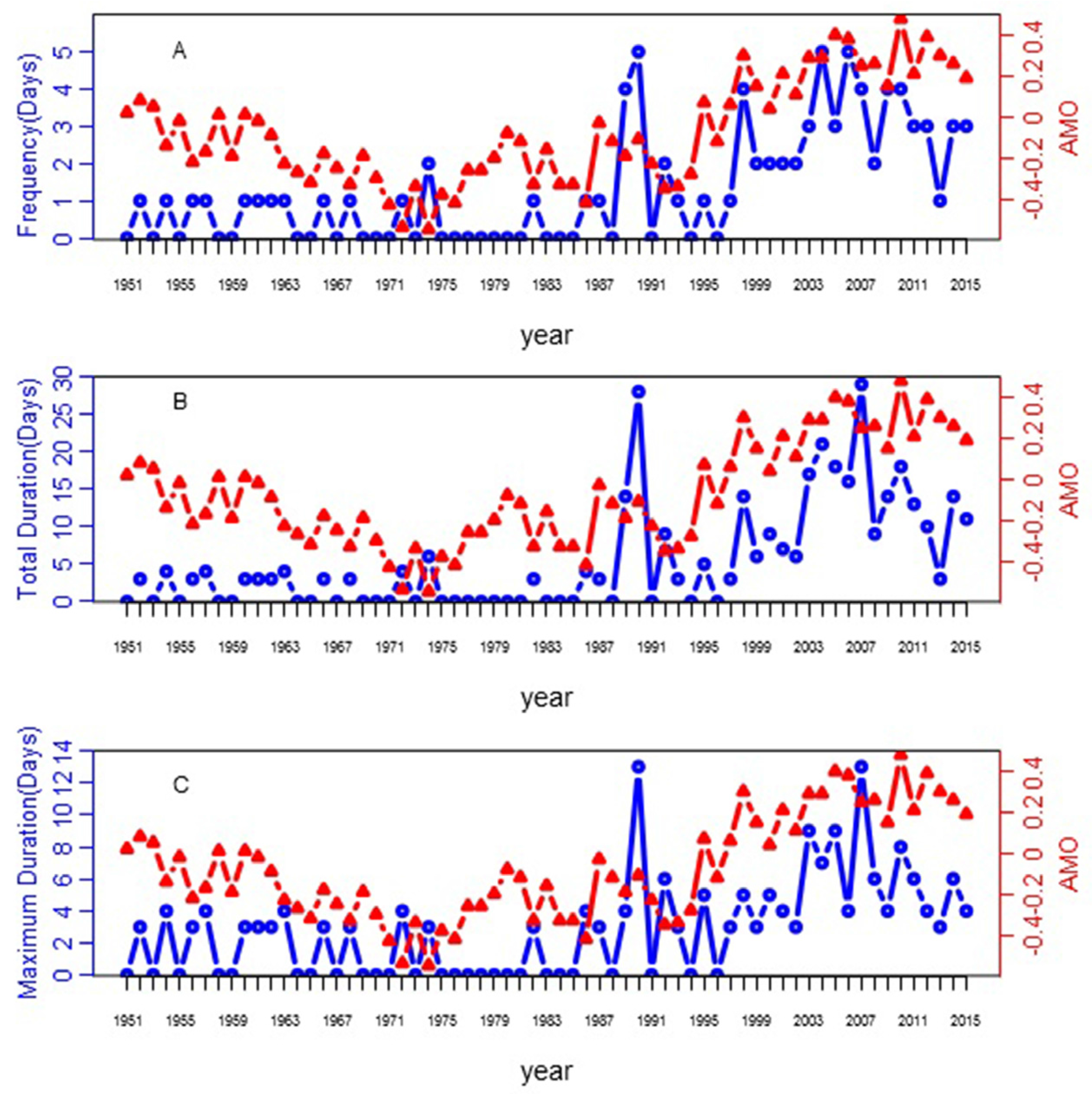


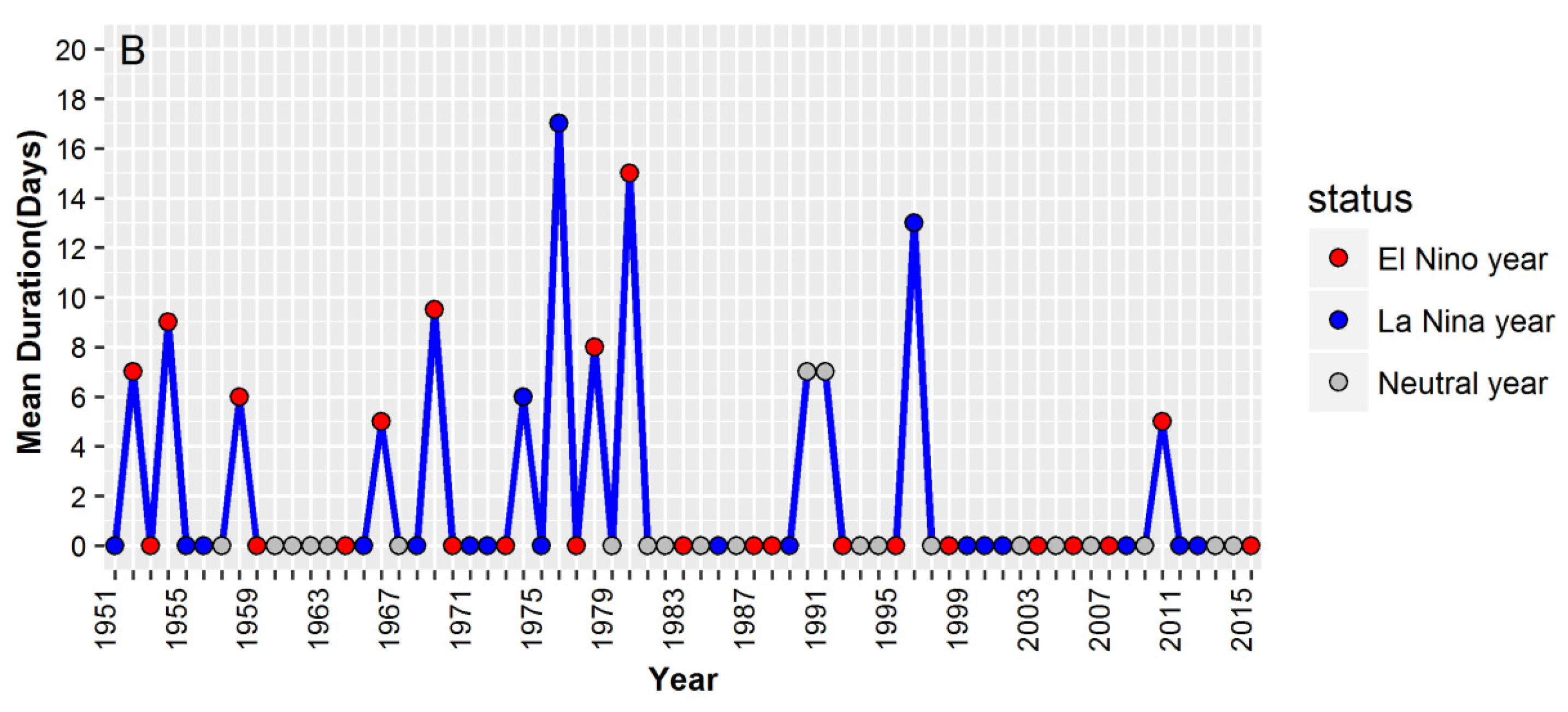
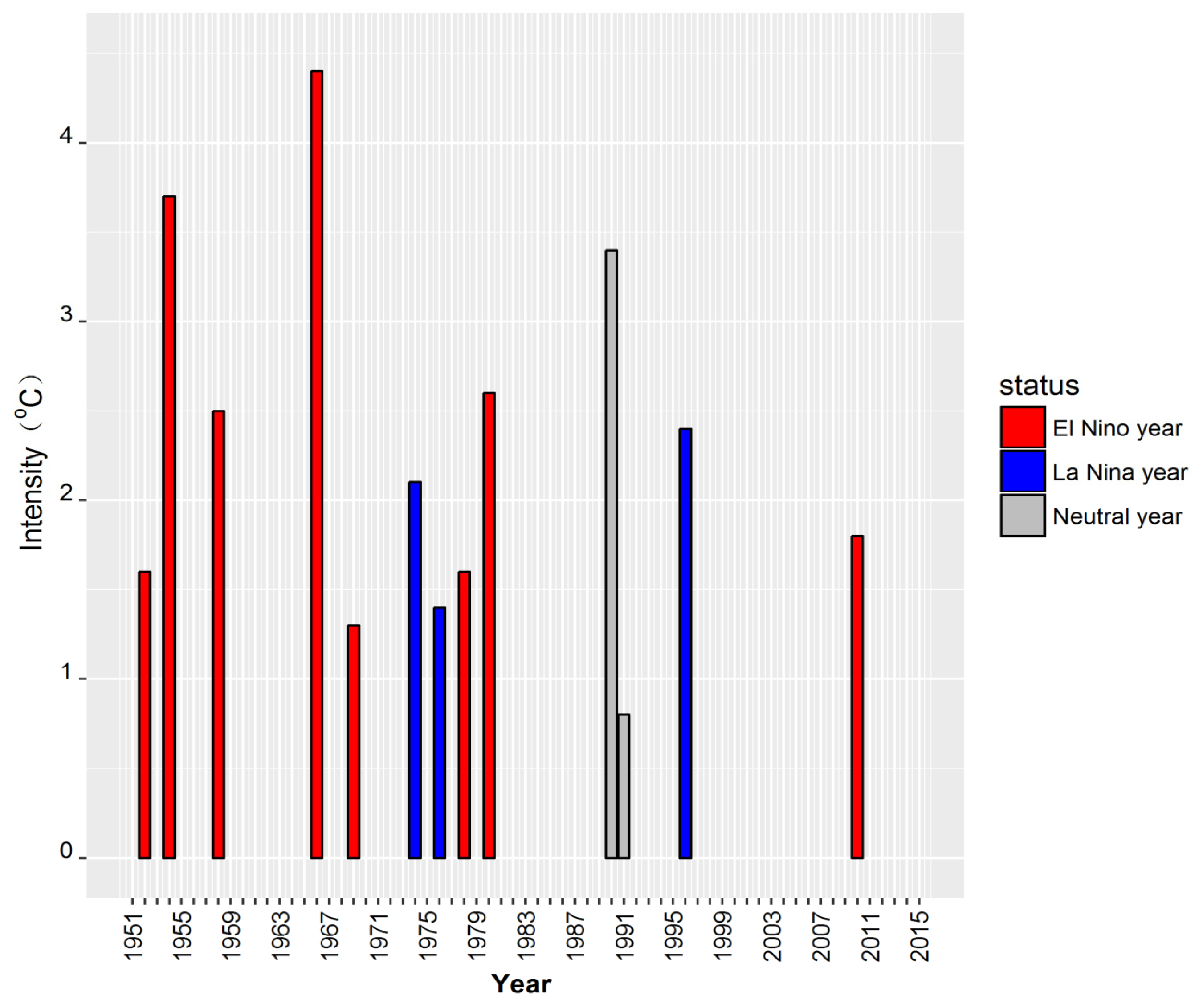
| Temperature Measures (°C) | Mean | Min | P5 | Median | P95 | Max | SD |
|---|---|---|---|---|---|---|---|
| Mean temperature (°C) | 22.07 | 2.09 | 10.70 | 23.50 | 29.70 | 34.20 | 6.17 |
| Minimum temperature (°C) | 18.94 | 0.00 | 7.30 | 20.60 | 26.40 | 30.40 | 6.32 |
| Maximum temperature (°C) | 26.49 | 4.30 | 14.30 | 27.70 | 34.50 | 39.10 | 6.34 |
© 2017 by the authors. Licensee MDPI, Basel, Switzerland. This article is an open access article distributed under the terms and conditions of the Creative Commons Attribution (CC BY) license ( http://creativecommons.org/licenses/by/4.0/).
Share and Cite
Zhang, R.; Chen, Z.-Y.; Ou, C.-Q.; Zhuang, Y. Trends of Heat Waves and Cold Spells over 1951–2015 in Guangzhou, China. Atmosphere 2017, 8, 37. https://doi.org/10.3390/atmos8020037
Zhang R, Chen Z-Y, Ou C-Q, Zhuang Y. Trends of Heat Waves and Cold Spells over 1951–2015 in Guangzhou, China. Atmosphere. 2017; 8(2):37. https://doi.org/10.3390/atmos8020037
Chicago/Turabian StyleZhang, Rong, Zhao-Yue Chen, Chun-Quan Ou, and Yan Zhuang. 2017. "Trends of Heat Waves and Cold Spells over 1951–2015 in Guangzhou, China" Atmosphere 8, no. 2: 37. https://doi.org/10.3390/atmos8020037





